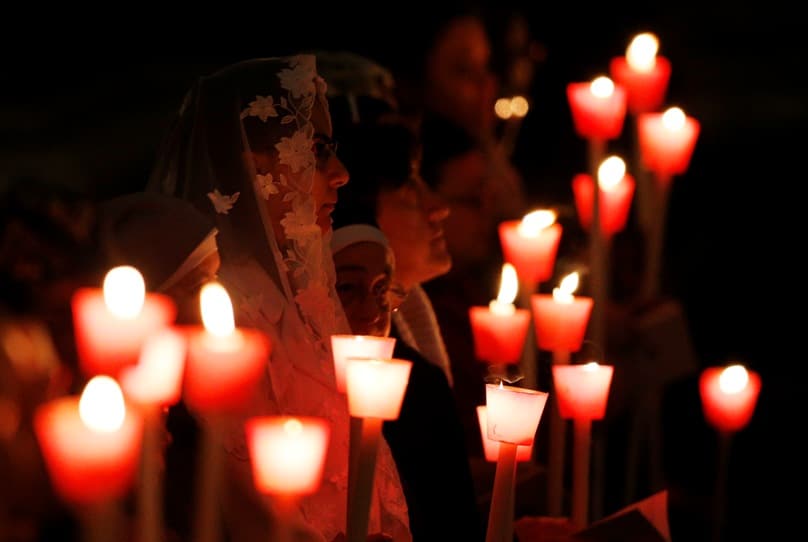
Dear Father, A friend recently took me to a Tridentine Rite Mass which I found very different from my normal parish Mass. It was celebrated in Latin and the priest had his back to the people. Where does this Mass come from and where does it fit into the Church’s liturgy?
Let us go back to the beginning. Ever since the Last Supper in which Christ instituted the Eucharist, telling the apostles to “do this in commemoration of me”, the Church has celebrated the Mass. At the beginning there were no printed texts and so bishops and priests said many of the prayers extemporaneously, following a set structure.
The Mass began with the Liturgy of the Word, with prayers asking for forgiveness of sins, readings from Sacred Scripture, a homily and prayers of intercession. This was followed by the Liturgy of the Eucharist, with the presentation of the gifts, the Canon or Eucharistic Prayer, the giving of Communion and the dismissal.
St Justin Martyr’s description of the Mass as it was celebrated in the middle of the second century can be found in the Catechism of the Catholic Church in paragraph 1345. The similarity with our present Mass is striking.
The basic elements of the Roman Canon, or Eucharistic Prayer I, were already there at the end of the fourth century in St Ambrose’s (c. 340-397) treatise De Sacramentis.
At the end of the sixth century, Pope St Gregory the Great (590-604) standardised the Mass, giving the Church the Roman Missal, which remained practically unchanged until the Second Vatican Council.
In the 16th century the Protestant reformers made drastic changes to the Mass, including to the Roman Canon, removing all elements that contradicted their new theology. To protect the traditional Mass and to ensure that it was celebrated in the same way throughout the Catholic world Pope St Pius V issued a new Roman Missal in 1570. This followed the directives of the Council of Trent, hence the name Tridentine Rite.
It should be understood, however, that the Roman Missal promulgated by Pope Pius V was not a new rite. It was essentially the same as that of Pope Gregory the Great. A more proper name for it is simply the Roman Rite.
Between 1570 and the Second Vatican Council numerous small changes were made to the missal, incorporating new feasts, changing the liturgical rank of some feasts, and adding the name of St Joseph in the Roman Canon in 1962. The last major edition of this missal was issued by Pope St John XXIII in 1962.
It incorporated some changes in the liturgy of Holy Week, abolished some vigils and octaves of feasts, removed some feasts for which there had been two celebrations, etc. The whole Church used this missal until 1970, when further changes were made as requested by the Second Vatican Council.
The council, in its Constitution on the Liturgy, Sacrosanctum Concilium, asked for revisions to be made so that “devout and active participation by the faithful may be more easily achieved. For this purpose the rites are to be simplified, due care being taken to preserve their substance.
Parts which with the passage of time came to be duplicated, or were added with little advantage, are to be omitted. Other parts which suffered loss through accidents of history are to be restored to the vigour they had in the days of the holy Fathers, as may seem useful or necessary” (n. 50). In particular, the council asked that more Scriptural passages be read, that the homily be given greater importance, that the prayer of the faithful after the homily be restored, etc. (cf. ibid.).
Accordingly a new Roman Missal incorporating these changes was introduced in 1970 and this is the missal we use in our parishes today. It is not a new rite but simply the latest revision of the traditional Roman Rite. It is properly referred to as the Ordinary Form of the Mass, and the Tridentine Rite, which uses the 1962 missal, as the Extraordinary Form.
The latest edition of the General Instruction of the Roman Missal (2012) speaks of “the new Missal with which the Church of the Roman Rite will henceforth celebrate the Mass”, indicating that this is to be the ordinary form of the Mass everywhere. But Mass can still be celebrated using the 1962 missal as the extraordinary form. It is improperly referred to as the Tridentine Rite. In short there is only one rite, the Roman Rite, with two forms of celebration.
